dashboard FIAT DOBLO COMBI 2015 2.G User Guide
[x] Cancel search | Manufacturer: FIAT, Model Year: 2015, Model line: DOBLO COMBI, Model: FIAT DOBLO COMBI 2015 2.GPages: 323, PDF Size: 46.77 MB
Page 117 of 323
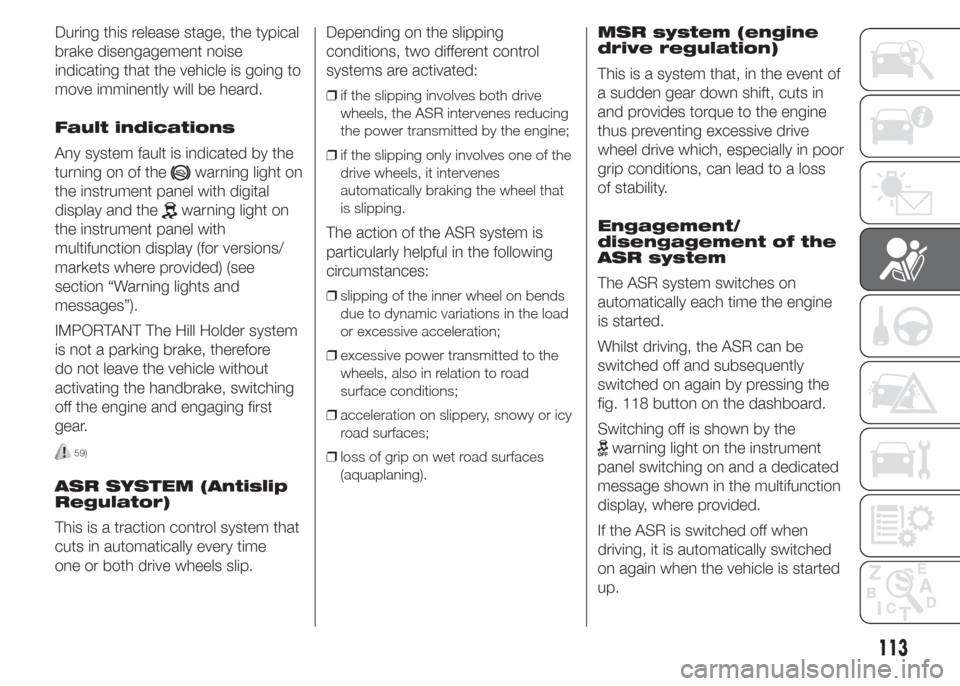
During this release stage, the typical
brake disengagement noise
indicating that the vehicle is going to
move imminently will be heard.
Fault indications
Any system fault is indicated by the
turning on of the
warning light on
the instrument panel with digital
display and the
warning light on
the instrument panel with
multifunction display (for versions/
markets where provided) (see
section “Warning lights and
messages”).
IMPORTANT The Hill Holder system
is not a parking brake, therefore
do not leave the vehicle without
activating the handbrake, switching
off the engine and engaging first
gear.
59)
ASR SYSTEM (Antislip
Regulator)
This is a traction control system that
cuts in automatically every time
one or both drive wheels slip.Depending on the slipping
conditions, two different control
systems are activated:
❒if the slipping involves both drive
wheels, the ASR intervenes reducing
the power transmitted by the engine;
❒if the slipping only involves one of the
drive wheels, it intervenes
automatically braking the wheel that
is slipping.
The action of the ASR system is
particularly helpful in the following
circumstances:
❒slipping of the inner wheel on bends
due to dynamic variations in the load
or excessive acceleration;
❒excessive power transmitted to the
wheels, also in relation to road
surface conditions;
❒acceleration on slippery, snowy or icy
road surfaces;
❒loss of grip on wet road surfaces
(aquaplaning).
MSR system (engine
drive regulation)
This is a system that, in the event of
a sudden gear down shift, cuts in
and provides torque to the engine
thus preventing excessive drive
wheel drive which, especially in poor
grip conditions, can lead to a loss
of stability.
Engagement/
disengagement of the
ASR system
The ASR system switches on
automatically each time the engine
is started.
Whilst driving, the ASR can be
switched off and subsequently
switched on again by pressing the
fig. 118 button on the dashboard.
Switching off is shown by the
warning light on the instrument
panel switching on and a dedicated
message shown in the multifunction
display, where provided.
If the ASR is switched off when
driving, it is automatically switched
on again when the vehicle is started
up.
113
Page 127 of 323
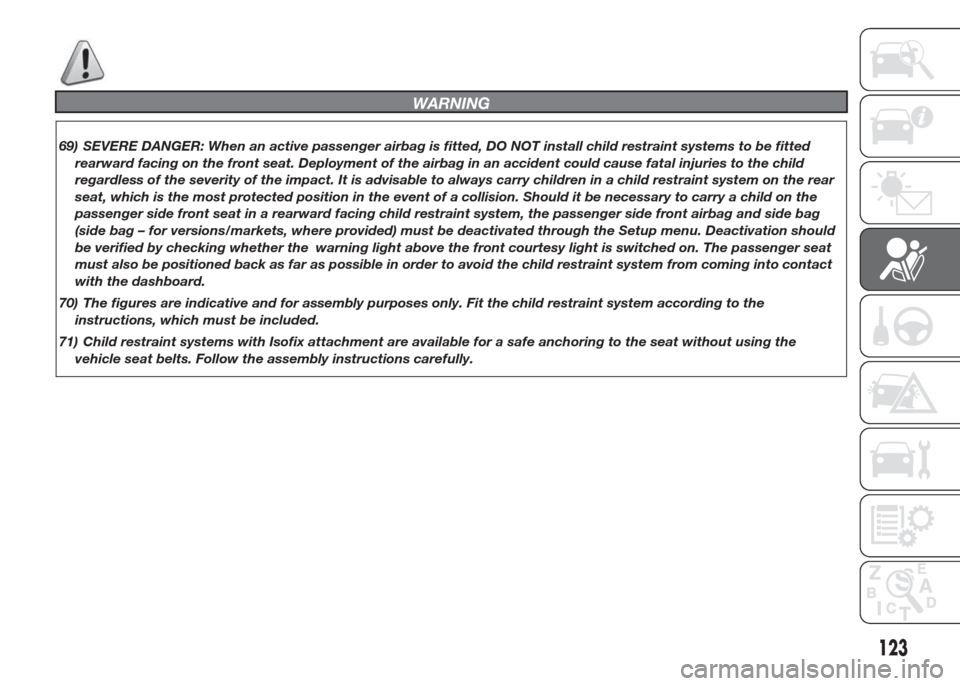
WARNING
69) SEVERE DANGER: When an active passenger airbag is fitted, DO NOT install child restraint systems to be fitted
rearward facing on the front seat. Deployment of the airbag in an accident could cause fatal injuries to the child
regardless of the severity of the impact. It is advisable to always carry children in a child restraint system on the rear
seat, which is the most protected position in the event of a collision. Should it be necessary to carry a child on the
passenger side front seat in a rearward facing child restraint system, the passenger side front airbag and side bag
(side bag – for versions/markets, where provided) must be deactivated through the Setup menu. Deactivation should
be verified by checking whether the warning light above the front courtesy light is switched on. The passenger seat
must also be positioned back as far as possible in order to avoid the child restraint system from coming into contact
with the dashboard.
70) The figures are indicative and for assembly purposes only. Fit the child restraint system according to the
instructions, which must be included.
71) Child restraint systems with Isofix attachment are available for a safe anchoring to the seat without using the
vehicle seat belts. Follow the assembly instructions carefully.
123
Page 131 of 323
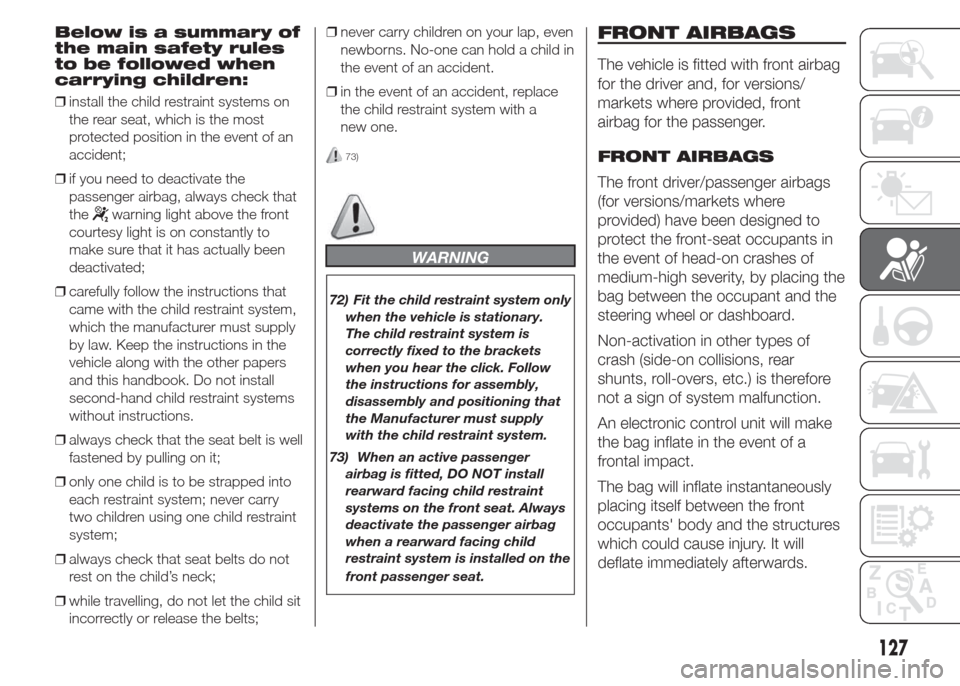
Below is a summary of
the main safety rules
to be followed when
carrying children:
❒install the child restraint systems on
the rear seat, which is the most
protected position in the event of an
accident;
❒if you need to deactivate the
passenger airbag, always check that
the
warning light above the front
courtesy light is on constantly to
make sure that it has actually been
deactivated;
❒carefully follow the instructions that
came with the child restraint system,
which the manufacturer must supply
by law. Keep the instructions in the
vehicle along with the other papers
and this handbook. Do not install
second-hand child restraint systems
without instructions.
❒always check that the seat belt is well
fastened by pulling on it;
❒only one child is to be strapped into
each restraint system; never carry
two children using one child restraint
system;
❒always check that seat belts do not
rest on the child’s neck;
❒while travelling, do not let the child sit
incorrectly or release the belts;❒never carry children on your lap, even
newborns. No-one can hold a child in
the event of an accident.
❒in the event of an accident, replace
the child restraint system with a
new one.
73)
WARNING
72) Fit the child restraint system only
when the vehicle is stationary.
The child restraint system is
correctly fixed to the brackets
when you hear the click. Follow
the instructions for assembly,
disassembly and positioning that
the Manufacturer must supply
with the child restraint system.
73) When an active passenger
airbag is fitted, DO NOT install
rearward facing child restraint
systems on the front seat. Always
deactivate the passenger airbag
when a rearward facing child
restraint system is installed on the
front passenger seat.
FRONT AIRBAGS
The vehicle is fitted with front airbag
for the driver and, for versions/
markets where provided, front
airbag for the passenger.
FRONT AIRBAGS
The front driver/passenger airbags
(for versions/markets where
provided) have been designed to
protect the front-seat occupants in
the event of head-on crashes of
medium-high severity, by placing the
bag between the occupant and the
steering wheel or dashboard.
Non-activation in other types of
crash (side-on collisions, rear
shunts, roll-overs, etc.) is therefore
not a sign of system malfunction.
An electronic control unit will make
the bag inflate in the event of a
frontal impact.
The bag will inflate instantaneously
placing itself between the front
occupants' body and the structures
which could cause injury. It will
deflate immediately afterwards.
127
Page 132 of 323
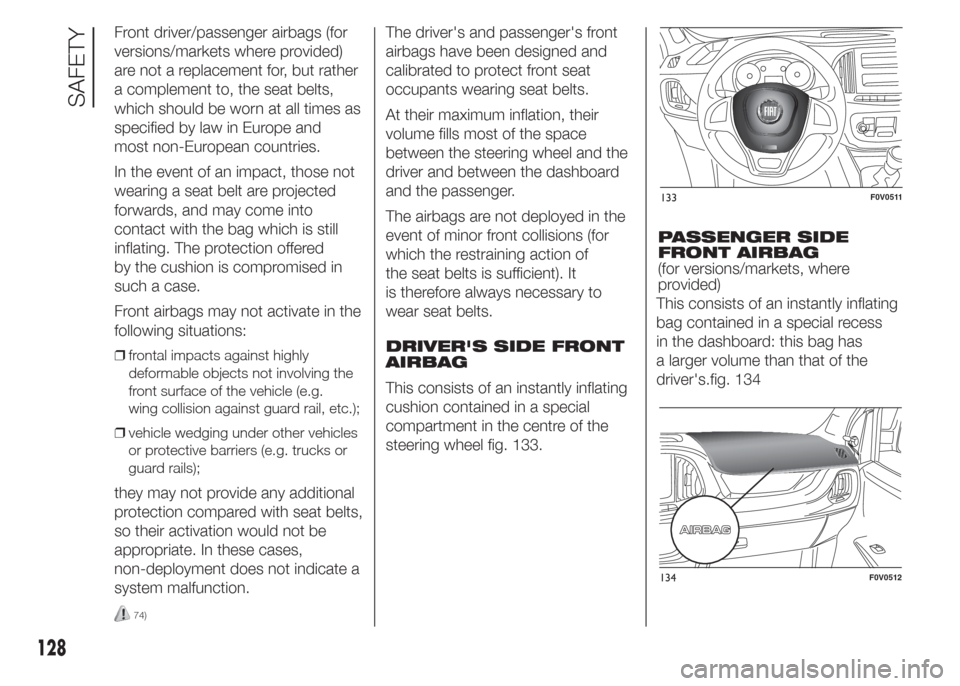
Front driver/passenger airbags (for
versions/markets where provided)
are not a replacement for, but rather
a complement to, the seat belts,
which should be worn at all times as
specified by law in Europe and
most non-European countries.
In the event of an impact, those not
wearing a seat belt are projected
forwards, and may come into
contact with the bag which is still
inflating. The protection offered
by the cushion is compromised in
such a case.
Front airbags may not activate in the
following situations:
❒frontal impacts against highly
deformable objects not involving the
front surface of the vehicle (e.g.
wing collision against guard rail, etc.);
❒vehicle wedging under other vehicles
or protective barriers (e.g. trucks or
guard rails);
they may not provide any additional
protection compared with seat belts,
so their activation would not be
appropriate. In these cases,
non-deployment does not indicate a
system malfunction.
74)
The driver's and passenger's front
airbags have been designed and
calibrated to protect front seat
occupants wearing seat belts.
At their maximum inflation, their
volume fills most of the space
between the steering wheel and the
driver and between the dashboard
and the passenger.
The airbags are not deployed in the
event of minor front collisions (for
which the restraining action of
the seat belts is sufficient). It
is therefore always necessary to
wear seat belts.
DRIVER'S SIDE FRONT
AIRBAG
This consists of an instantly inflating
cushion contained in a special
compartment in the centre of the
steering wheel fig. 133.PASSENGER SIDE
FRONT AIRBAG
(for versions/markets, where
provided)
This consists of an instantly inflating
bag contained in a special recess
in the dashboard: this bag has
a larger volume than that of the
driver's.fig. 134
133F0V0511
134F0V0512
128
SAFETY
Page 135 of 323
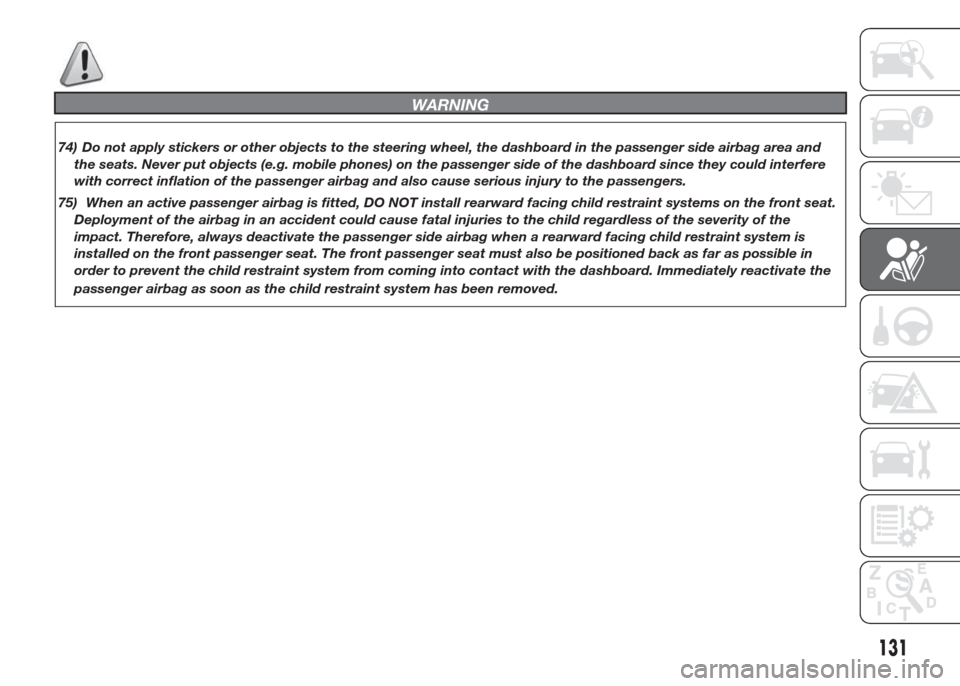
WARNING
74) Do not apply stickers or other objects to the steering wheel, the dashboard in the passenger side airbag area and
the seats. Never put objects (e.g. mobile phones) on the passenger side of the dashboard since they could interfere
with correct inflation of the passenger airbag and also cause serious injury to the passengers.
75) When an active passenger airbag is fitted, DO NOT install rearward facing child restraint systems on the front seat.
Deployment of the airbag in an accident could cause fatal injuries to the child regardless of the severity of the
impact. Therefore, always deactivate the passenger side airbag when a rearward facing child restraint system is
installed on the front passenger seat. The front passenger seat must also be positioned back as far as possible in
order to prevent the child restraint system from coming into contact with the dashboard. Immediately reactivate the
passenger airbag as soon as the child restraint system has been removed.
131
Page 140 of 323
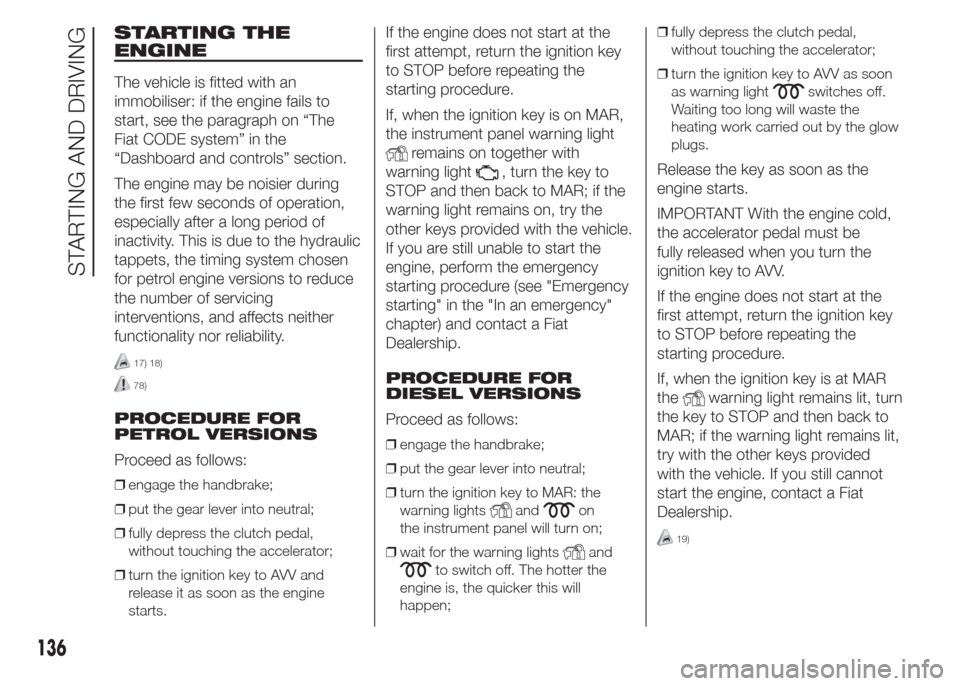
STARTING THE
ENGINE
The vehicle is fitted with an
immobiliser: if the engine fails to
start, see the paragraph on “The
Fiat CODE system” in the
“Dashboard and controls” section.
The engine may be noisier during
the first few seconds of operation,
especially after a long period of
inactivity. This is due to the hydraulic
tappets, the timing system chosen
for petrol engine versions to reduce
the number of servicing
interventions, and affects neither
functionality nor reliability.
17) 18)
78)
PROCEDURE FOR
PETROL VERSIONS
Proceed as follows:
❒engage the handbrake;
❒put the gear lever into neutral;
❒fully depress the clutch pedal,
without touching the accelerator;
❒turn the ignition key to AVV and
release it as soon as the engine
starts.
If the engine does not start at the
first attempt, return the ignition key
to STOP before repeating the
starting procedure.
If, when the ignition key is on MAR,
the instrument panel warning light
remains on together with
warning light
, turn the key to
STOP and then back to MAR; if the
warning light remains on, try the
other keys provided with the vehicle.
If you are still unable to start the
engine, perform the emergency
starting procedure (see "Emergency
starting" in the "In an emergency"
chapter) and contact a Fiat
Dealership.
PROCEDURE FOR
DIESEL VERSIONS
Proceed as follows:
❒engage the handbrake;
❒put the gear lever into neutral;
❒turn the ignition key to MAR: the
warning lights
andon
the instrument panel will turn on;
❒wait for the warning lights
and
to switch off. The hotter the
engine is, the quicker this will
happen;❒fully depress the clutch pedal,
without touching the accelerator;
❒turn the ignition key to AVV as soon
as warning light
switches off.
Waiting too long will waste the
heating work carried out by the glow
plugs.
Release the key as soon as the
engine starts.
IMPORTANT With the engine cold,
the accelerator pedal must be
fully released when you turn the
ignition key to AVV.
If the engine does not start at the
first attempt, return the ignition key
to STOP before repeating the
starting procedure.
If, when the ignition key is at MAR
the
warning light remains lit, turn
the key to STOP and then back to
MAR; if the warning light remains lit,
try with the other keys provided
with the vehicle. If you still cannot
start the engine, contact a Fiat
Dealership.
19)
136
STARTING AND DRIVING
Page 177 of 323
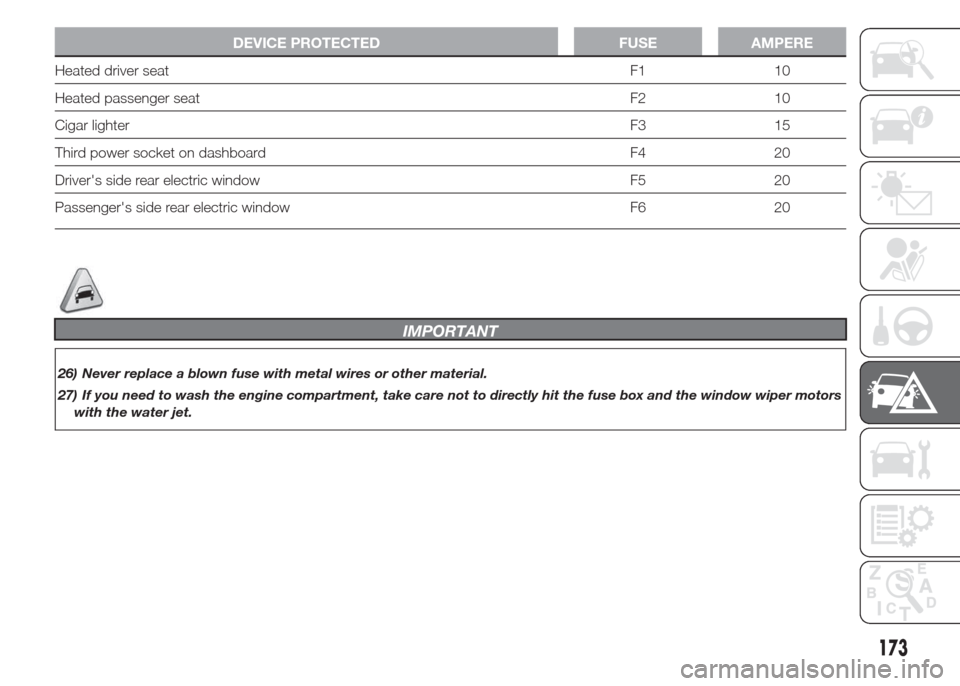
DEVICE PROTECTED FUSE AMPERE
Heated driver seat F1 10
Heated passenger seat F2 10
Cigar lighterF3 15
Third power socket on dashboard F4 20
Driver's side rear electric window F5 20
Passenger's side rear electric window F6 20
IMPORTANT
26) Never replace a blown fuse with metal wires or other material.
27) If you need to wash the engine compartment, take care not to directly hit the fuse box and the window wiper motors
with the water jet.
173
Page 189 of 323
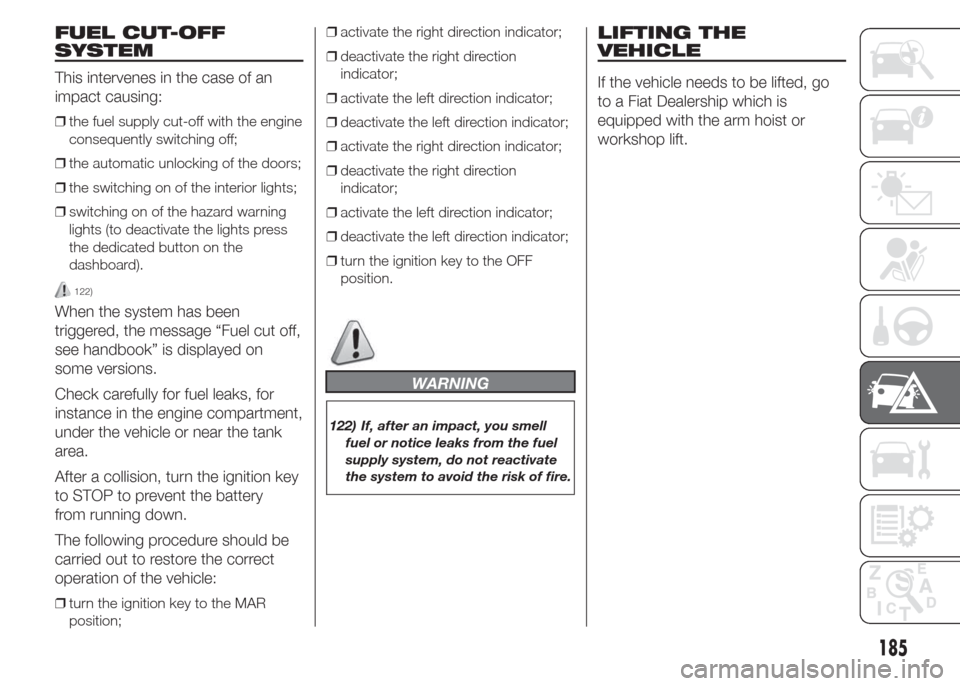
FUEL CUT-OFF
SYSTEM
This intervenes in the case of an
impact causing:
❒the fuel supply cut-off with the engine
consequently switching off;
❒the automatic unlocking of the doors;
❒the switching on of the interior lights;
❒switching on of the hazard warning
lights (to deactivate the lights press
the dedicated button on the
dashboard).
122)
When the system has been
triggered, the message “Fuel cut off,
see handbook” is displayed on
some versions.
Check carefully for fuel leaks, for
instance in the engine compartment,
under the vehicle or near the tank
area.
After a collision, turn the ignition key
to STOP to prevent the battery
from running down.
The following procedure should be
carried out to restore the correct
operation of the vehicle:
❒turn the ignition key to the MAR
position;❒activate the right direction indicator;
❒deactivate the right direction
indicator;
❒activate the left direction indicator;
❒deactivate the left direction indicator;
❒activate the right direction indicator;
❒deactivate the right direction
indicator;
❒activate the left direction indicator;
❒deactivate the left direction indicator;
❒turn the ignition key to the OFF
position.
WARNING
122) If, after an impact, you smell
fuel or notice leaks from the fuel
supply system, do not reactivate
the system to avoid the risk of fire.
LIFTING THE
VEHICLE
If the vehicle needs to be lifted, go
to a Fiat Dealership which is
equipped with the arm hoist or
workshop lift.
185
Page 219 of 323
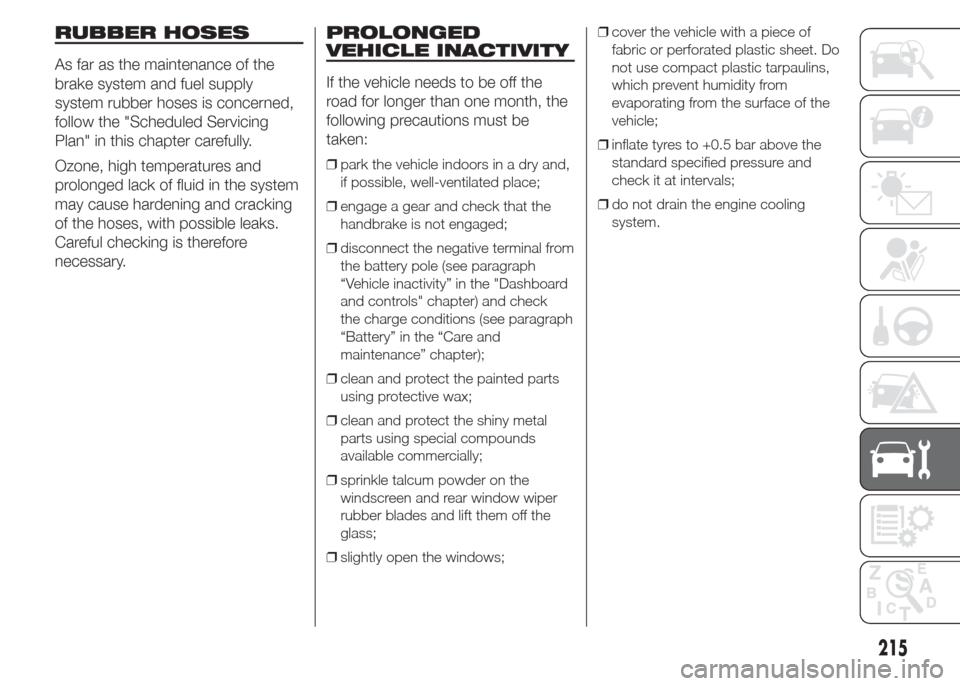
RUBBER HOSES
As far as the maintenance of the
brake system and fuel supply
system rubber hoses is concerned,
follow the "Scheduled Servicing
Plan" in this chapter carefully.
Ozone, high temperatures and
prolonged lack of fluid in the system
may cause hardening and cracking
of the hoses, with possible leaks.
Careful checking is therefore
necessary.
PROLONGED
VEHICLE INACTIVITY
If the vehicle needs to be off the
road for longer than one month, the
following precautions must be
taken:
❒park the vehicle indoors in a dry and,
if possible, well-ventilated place;
❒engage a gear and check that the
handbrake is not engaged;
❒disconnect the negative terminal from
the battery pole (see paragraph
“Vehicle inactivity” in the "Dashboard
and controls" chapter) and check
the charge conditions (see paragraph
“Battery” in the “Care and
maintenance” chapter);
❒clean and protect the painted parts
using protective wax;
❒clean and protect the shiny metal
parts using special compounds
available commercially;
❒sprinkle talcum powder on the
windscreen and rear window wiper
rubber blades and lift them off the
glass;
❒slightly open the windows;❒cover the vehicle with a piece of
fabric or perforated plastic sheet. Do
not use compact plastic tarpaulins,
which prevent humidity from
evaporating from the surface of the
vehicle;
❒inflate tyres to +0.5 bar above the
standard specified pressure and
check it at intervals;
❒do not drain the engine cooling
system.
215